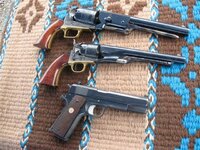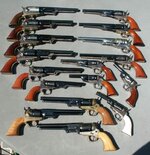- Messages
- 51
- Reactions
- 0
I'm thinking of this from a "Top Shot" perspective. If you found yourself anywhere within the last 200 years in America or on an American battlefield on foreign soil, could you pick up any rifle or handgun and immediately and expertly use it?
To accomplish this you would have to be thoroughly familiar and proficient with at least a minimum of firearm models and types. So I put together a list of ultimate top firearms of each type that I think you might run into and that would have transferable proficiency to most others of the era.
These are what I would pick to practice with today if I was going anywhere into the past 200 years and had to be proficient with any firearm I might encounter.
Rifles:
Kentucky Rifle (flintlock)
Zouave Rifle (percussion)
Springfield Model 1873 (.45-70)
Winchester 1873 (.44-40)
Springfield M1903
M1 Garand
AR15
Pistols:
Harper Ferry's Model 1806
Deringer
Colt 1847 Walker
Colt 1873 Single Action Army
Mauser M1896 "Broomhandle"
Luger P-08
Colt 1911
Smith & Wesson Model 29 (.44 Magnum)
CZ-75 (9mm)
Shotguns:
Double Barrel Coach Gun (of any manufacture)
Winchester 1897
Saiga-12
What I learned putting this list together is just seven rifle types easily covers 200 years. Flintlock and percussion covers muzzleloaders, the Springfield .45-70 covers the single shot rifles of the era, and one great lever-action rifle, the 1873, covers the basics of them all. The Springfield M1903 represents the best bolt-action learning tool ever built, and the Garand covers semi-auto battlerifles so well that further M14 training is not needed. The AR15 blankets the last 50 years of rifles with nothing superior or that very different in sight.
The Pistol list was more complicated because there are so many types to become familiar with. But the funny thing is, since the CZ came out 1975, no further specialized familiarity with other types is absolutely required, so it still was only nine in total. Glock, XD, Beretta, etc., are all functionally about the same with only minor differences. It would be far more important to spend your time learning the intricacies of a "Broomhandle" Mauser, a Luger, a Deringer, or a Smith & Wesson revolver than on the minor differences of modern semi-auto pistols. I chose an 1847 Walker not only because it was the first of it's great type, but because it is both similar too and harder to master than the Colt 1860 Army, so a better learning tool, even though the 1860 Army is a better overall pistol.
Shotguns are easy with few major changes over two centuries. The Saiga-12 is box fed so is more representative of "modern" semi-auto design rather than old tube fed designs that more closely resemble the 1897 pump in operation. So three shotguns will cover it.
I think training with these 19 models would cover my firearms proficiency for the past 200 years.
Did I leave anything out or would you choose anything different for training purposes?
To accomplish this you would have to be thoroughly familiar and proficient with at least a minimum of firearm models and types. So I put together a list of ultimate top firearms of each type that I think you might run into and that would have transferable proficiency to most others of the era.
These are what I would pick to practice with today if I was going anywhere into the past 200 years and had to be proficient with any firearm I might encounter.
Rifles:
Kentucky Rifle (flintlock)
Zouave Rifle (percussion)
Springfield Model 1873 (.45-70)
Winchester 1873 (.44-40)
Springfield M1903
M1 Garand
AR15
Pistols:
Harper Ferry's Model 1806
Deringer
Colt 1847 Walker
Colt 1873 Single Action Army
Mauser M1896 "Broomhandle"
Luger P-08
Colt 1911
Smith & Wesson Model 29 (.44 Magnum)
CZ-75 (9mm)
Shotguns:
Double Barrel Coach Gun (of any manufacture)
Winchester 1897
Saiga-12
What I learned putting this list together is just seven rifle types easily covers 200 years. Flintlock and percussion covers muzzleloaders, the Springfield .45-70 covers the single shot rifles of the era, and one great lever-action rifle, the 1873, covers the basics of them all. The Springfield M1903 represents the best bolt-action learning tool ever built, and the Garand covers semi-auto battlerifles so well that further M14 training is not needed. The AR15 blankets the last 50 years of rifles with nothing superior or that very different in sight.
The Pistol list was more complicated because there are so many types to become familiar with. But the funny thing is, since the CZ came out 1975, no further specialized familiarity with other types is absolutely required, so it still was only nine in total. Glock, XD, Beretta, etc., are all functionally about the same with only minor differences. It would be far more important to spend your time learning the intricacies of a "Broomhandle" Mauser, a Luger, a Deringer, or a Smith & Wesson revolver than on the minor differences of modern semi-auto pistols. I chose an 1847 Walker not only because it was the first of it's great type, but because it is both similar too and harder to master than the Colt 1860 Army, so a better learning tool, even though the 1860 Army is a better overall pistol.
Shotguns are easy with few major changes over two centuries. The Saiga-12 is box fed so is more representative of "modern" semi-auto design rather than old tube fed designs that more closely resemble the 1897 pump in operation. So three shotguns will cover it.
I think training with these 19 models would cover my firearms proficiency for the past 200 years.
Did I leave anything out or would you choose anything different for training purposes?














